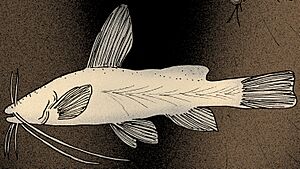Widemouth blindcat facts for kids
Quick facts for kids Widemouth blindcat |
|
|---|---|
 |
|
| Conservation status | |
| Scientific classification | |
| Genus: |
Satan
|
| Species: |
eurystomus
|
The widemouth blindcat (Satan eurystomus) is a special type of catfish. It lives only in Texas, United States. This fish is the only one of its kind in the group known as Satan. It's a unique creature that has adapted to life deep underground.
Contents
About the Widemouth Blindcat
This amazing fish was first found living in a well. It is perfectly suited for a dark, underground home. Like other cavefish, the widemouth blindcat has no color in its skin. It also has no eyes that you can see from the outside.
Physical Features of the Blindcat
The parts of its eyes that are left are very tiny. They have almost no retina or lens. The nerve that connects the eye to the brain is there. But it shrinks before it reaches the brain. This means the fish cannot see.
The widemouth blindcat's swim bladder is small. This bladder usually helps fish float. Its skull is mostly soft cartilage. It is not as hard as the bones of most other adult catfish. The lateral line system helps fish sense movement. In this fish, it is broken up. It does not go past the front part of its anal fin.
Unique Traits of the Blindcat
This species also keeps some young traits as an adult. This is called paedomorphosis. You can see this in its small size. Its kidneys and soft skeleton also show this. The widemouth blindcat can grow to about 13.7 cm (5.4 in) long.
Widemouth Blindcat Family Tree
The closest relative to the widemouth blindcat is the much larger flathead catfish. The flathead catfish is known as Pylodictis olivaris.
Where the Blindcat Lives
The widemouth blindcat lives in artesian wells. These are wells where water flows up naturally from underground. It shares its home with another blind fish. This fish is called the toothless blindcat (Trogloglanis pattersoni).
Blindcat Habitat in Texas
Both of these fish live in five wells. These wells go into the San Antonio Pool. This is part of the Edwards Aquifer in and near San Antonio, Texas. Scientists have found parts of crustacean shells in their stomachs. This suggests they eat crustaceans. They might even be the top predator in their underground world.
Protecting the Widemouth Blindcat
The widemouth blindcat is a vulnerable species. This means it is at risk of becoming endangered. Its biggest threat is groundwater pollution. This happens when harmful substances get into the underground water.
Conservation Efforts for the Blindcat
In 2023, the U.S. Fish and Wildlife Service suggested a plan. They want to list the widemouth blindcat as endangered. This would happen under the Endangered Species Act of 1973. The toothless blindcat, which lives in the same area, would also be listed. This law helps protect animals that are in danger.
See also
- Blindness in animals



